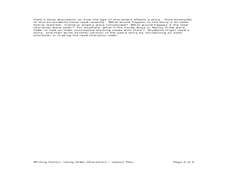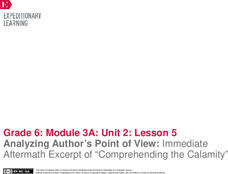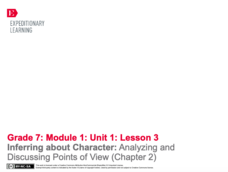Curated OER
Comic Book Characters
Explore gender stereotypes by analyzing how male and female characters are depicted in comic books. Using the provided Comic Book Analysis sheet, students record the attributes of male and female comic book characters. Then the whole...
Curated OER
CAN WE SWITCH GENDERS OF STORY CHARACTERS?
Analyze characters and stories to identify stereotyping. Learners will examine the concept of character gender to evaluate bias in classroom story books. They are asked to read a story or play and change the gender of the character to...
Curated OER
Dear Diary
Work on narrative writing with this lesson, in which middle schoolers analyze the characters from a selected piece of literature and write narrative diary pieces as the character. They work to understand the point of view of the...
Curated OER
A Boxful of Character
I can't wait to try this activity with my class. It's versatile and could be modified to fit any character analysis lesson. To analyze characters thoroughly, learners create life boxes. Each box will pertain to a character from any...
Curated OER
Understanding Characters
Students analyzing characters from a story by creating an article about one. In this story analysis lesson, students read Charlie and the Chocolate Factory by Roald Dahl, and pick one character to write descriptively about. Students...
Curated OER
Analyzing Folklore: Redwall
Brian Jacques’ novel Redwall provides the focus for a series of lessons involving the analysis of folklore. Adopting the persona of a character, groups write letters in the voice of their character, assemble a collage using Microsoft...
Curated OER
Writing Fiction: Using Older Characters
Out with the old and in with the new? Not so in this lesson plan, which explores the idea of writing older characters in fiction. Students learn the value of varying their characters, exploring different perspectives, and avoiding...
Hawaiʻi State Department of Education
Characters from a Box
Character analysis is a skill we use when we read literary works or want to write a good story. Learners will use drama to practice character analysis while focusing on the details that make characters act the way they do. They'll each...
Curated OER
Creating Characters
Students examine the methods of effective characterization. In this writing skills lesson, students discuss how emotions, dialogue, actions, and physical descriptions build believable characters. Students then use the methods of...
EngageNY
Analyzing Author’s Point of View: Immediate Aftermath Excerpt of “Comprehending the Calamity"
Analyze that! Scholars continue reading and analyzing a primary source about the immediate aftermath of the 1906 San Francisco fire and earthquake. Then, individuals use graphic organizers to identify the author's point of view.
EngageNY
World Café to Analyze the Characters in Lyddie
Order up! Welcome to the World Café, where scholars engage in small-group discussions based on Katherine Paterson's novel Lyddie. As pupils circulate around the room, they talk with classmates about the novel's characters, setting, and...
EngageNY
Analyzing Word Choice: Understanding Working Conditions in the Mills
Ravenous or hungry, happy or ecstatic—why does word choice matter? Scholars continue to analyze working conditions in the mill and how the conditions affect the protagonist of Katherine Paterson's novel, Lyddie. They engage in a close...
EngageNY
Analyzing Language, Character, and Theme: World Café Discussion
As part of their study of A Midsummer Night's Dream, class members meet in a drama circle to discuss and role-play scenes from the play. They then engage in an activity called World Cafe, analyzing the characters' actions from the text....
EngageNY
Inferring about Character: Analyzing and Discussing Points of View (Chapter 2)
Readers engage in discussion with partners to answer questions about A Long Walk to Water by Linda Sue Park. Next, they complete exit tickets, writing about how the author creates different points of view for her characters.
EngageNY
Analyzing Point of View and Figurative Language: Chapter 3
Get to the point ... the point of view, that is! Pupils analyze Laurence Yep's Dragonwings for tone, figurative language, and point of view by completing graphic organizers. Scholars also read an excerpt from the novel and record the...
Curated OER
Analyzing Plot Conflict
Students explore the connection between analyzing a character and the character plot conflict. In this plot conflict lesson students role play two characters in the story, The Wizard of Oz by L. Frank Baum. Students also pretend to be a...
Curated OER
Contrasting Characters
Students analyze characters in a story and contrast them in terms of their appearance, education, family, religion, and more. In this characters lesson plan, students fill out a worksheet provided.
Curated OER
Analyzing Relationships
Fifth graders analyze character relationships. In this analyzing relationships lesson, 5th graders read The Great Gilly Hopkins and describe how the characters feel about one another as well as the positive and negative aspects of their...
Santa Ana Unified School District
Characters
Are your learners only talking about the plot of the story and not the richness of the characters? Then show them how important characters are to literature with the information available here. The learner will know how authors create...
Curated OER
Everyone's a Critic: Analyzing Sitcoms as Cultural Texts
Start by defining the word sitcom with the goal of launching a discussion. What exactly is a sitcom? How is a sitcom different from sketch comedy, drama, and reality television? Class members give examples, remember storylines they've...
Curated OER
How Characters Get What They Want
Sixth graders analyze the primary force that drives a character's actions in a character analysis lesson plan. In this character analysis lesson plan, 6th graders analyze how characters present their actions and participate in a group...
Polk Bros Foundation
I Can Analyze a Story or History Completely and Carefully
Start off analysis of a text with a worksheet that asks pupils to complete several tasks. Class members note down a couple of characters or people and their distinguishing traits, describe the most important event, summarize the text...
Curated OER
Remembrance of Yours--Analyzing Characters Using Mementos
Students choose two characters in Hamlet and symbolize the characters with an object, or find an object that the characters might carry. In this Hamlet lesson, students find an object to represent each character they choose. The object...
Curated OER
Number the Stars, Lesson 3
Students consider how an author creates a feeling of suspense in a reader's mind. They analyze characters in the story. Students make a character map for Peter. They discuss how suspense unfolds in the novel Number the Stars.

























